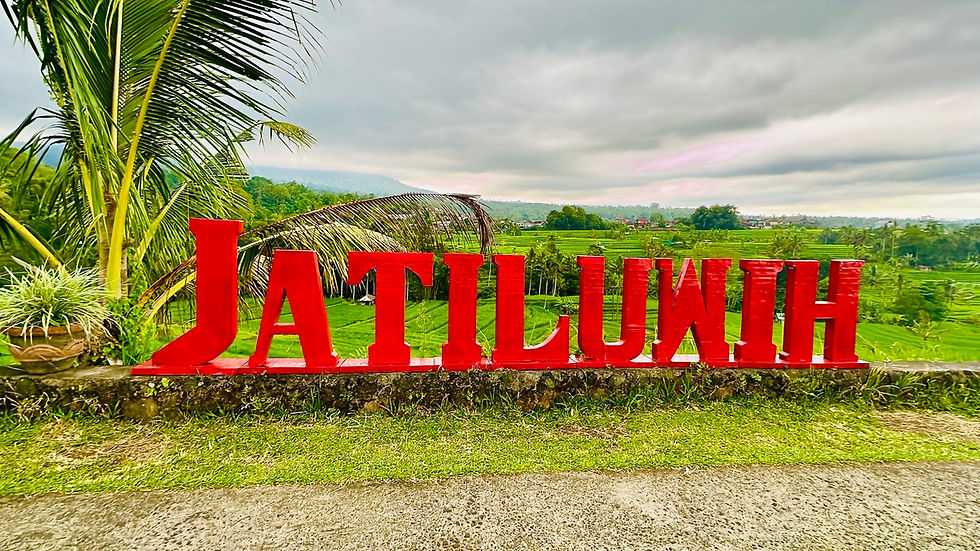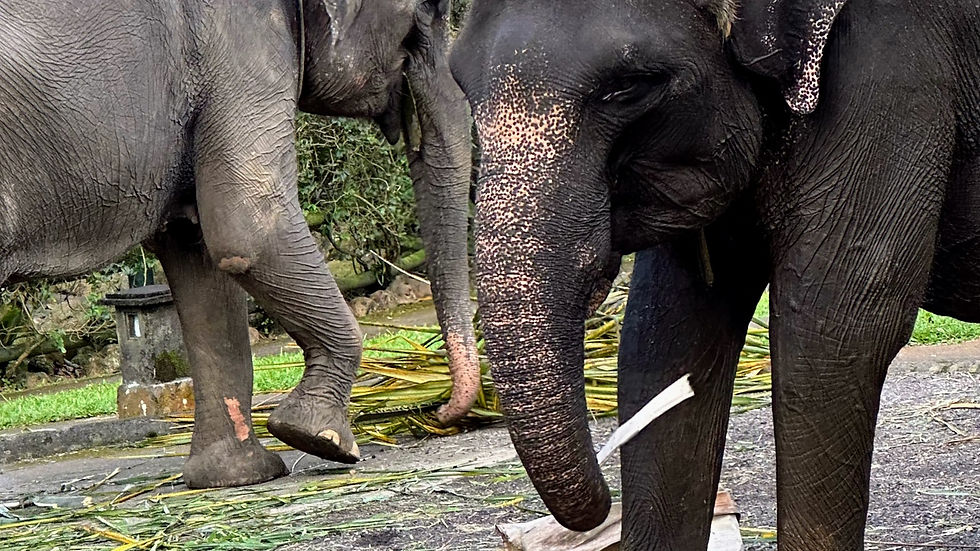Fields of Gold: Walking Through Bali’s Majestic Jatiluwih Rice Terraces
- Toni Reid
- Aug 20
- 4 min read

I missed the golf cart.
There’s a little open-air buggy that can glide you through the Jatiluwih Rice Terraces like a royal on a velvet path of green. But I showed up too late… or maybe the universe just knew I needed to walk.
And I’m glad I did.
Because this wasn’t just a scenic stroll. This was a walk through history, harmony, and living culture — a 600-hectare tapestry of rice, reverence, and rhythm under the Bali sky.
This isn’t just farmland. This is Jatiluwih — Bali’s largest rice terrace, a UNESCO World Heritage Site, and one of the most soul-stretching places I’ve visited.

🌾 What Are the Jatiluwih Rice Terraces?
Located in Tabanan Regency, nestled in the cool highlands of central Bali, Jatiluwih (jah-tee-loo-weeh) means “truly beautiful.” It's a name that sounds like poetry — and it delivers.
This sweeping green expanse covers over 600 hectares — nearly 1,500 acres — of cascading, layered rice fields that roll down the foothills of Mount Batukaru. Every step, every curve, every stone in these terraces was carved by hand. Generation after generation.
Imagine a green ocean, still and vast, breathing with the pulse of the island.
📅 When to Visit: The Most Vibrant Times of Year
The terraces change color with the seasons — and your experience will shift with them.
🌱 February to April: Peak green. The rice plants are lush, tall, and almost neon in color — absolutely magical for photography and pure visual awe.
🌾 April to June: Harvest season. You’ll see golden hues, farmers in full swing, and even ceremonies in the fields.
🛌 December to January: Quieter but still beautiful — just be ready for a bit more rain.
☀️ I visited in early April — and the fields were glowing. Like someone turned up the saturation in real life.

📍 How to Get to Jatiluwih (My Experience)
I arranged a private driver directly through my villa in Ubud, and the cost was totally reasonable — around IDR 500,000–600,000 (~$30–40 USD) for a round-trip day adventure, including a few stops along the way.
⏱️ Travel Time:
From Ubud: ~90 minutes
From Canggu/Seminyak: ~2 hours (longer if Bali’s in full moon traffic chaos)
🎟️ Entrance Fee: IDR 40,000 (~$2.50 USD). Bring cash — it’s Bali. You’ll want it for coconuts, tips, and road snacks.

💧 Why These Fields Are Sacred: The Subak System
What makes Jatiluwih more than just a pretty field is the Subak irrigation system — a cooperative, spiritual water-sharing method developed over 1,000 years ago.
Subak isn’t just engineering. It’s philosophy in practice — rooted in Tri Hita Karana, the Balinese principle of harmony between people, nature, and the gods.
Farmers here manage water like a sacred ritual. No machinery. No automation. Just bamboo pipes, carved mud trenches, and pure ancestral knowledge.
I saw it in motion — water trickling softly through the terraces, guided by hand, whispered to by farmers in wide-brimmed straw hatsAn.

🍚 What Kind of Rice Is Grown in Jatiluwih?
Here, they grow a unique variety of red rice called Beras Merah Jatiluwih — a slow-growing, nutrient-rich strain that’s different from the white rice you’ll find in most tourist plates across Bali.
What makes it special?
🌾 It’s grown without chemicals
🐌 It matures slowly (about 6 months per cycle)
🧘 It’s considered more spiritually pure and often used in temple offerings and ceremonies
🍴 Locals love it for its nutty flavor and high nutritional value
You won’t find it exported to global supermarkets. This rice is for the island — for offerings, for families, for festivals. In other words, it’s not a commodity. It’s a community.

🥾 Walking the Fields: A Slow, Sacred Journey
I won’t lie — I was sweating. The sun was high, the trail stretched endlessly, and a few dogs barked at me like I didn’t belong.
But the land pulled me in.
Scarecrows in button-down shirts. Farmers hunched in the fields, knee-deep in water, planting one seedling at a time. Butterfly clouds. The scent of wet earth and distant incense. And not a single loud tourist shouting “Baliiii!” into a drone.
You feel the work here. You see the reverence. You learn what patience looks like — in green layers and rippling light.
I walked for nearly an hour. I didn’t rush. And somewhere around the second curve, I forgot about missing the cart. I was exactly where I needed to be.
🧃 Gong Jatiluwih: A Meal With the Best View in Bali
After wandering through one of the most iconic rice fields in the world, I made my way to Gong Jatiluwih Restaurant & Lounge, perched right above the terraces.
✨ Order tip: Fresh watermelon juice and nasi campur with red rice.
I kicked off my dusty shoes, slid into a breezy table near the railing, and just stared. Mist hovered over the mountains. Palm trees waved lazily. Below, the paddies shimmered under the late-afternoon sun.
This isn’t the Bali of beach clubs and boutique cocktails. This is the Bali that breathes slower. That speaks softer. And it’s even better than the hype.

✨ Culture Crew Travel Tips for Jatiluwih
🕰️ Visit early — golden hour in the morning is unmatched. 🥾 Wear proper shoes — trails can be muddy and uneven. 💧 Hydrate — and bring your own water bottle. 💵 Bring small cash — for snacks, coconuts, tips, or donations. 🚶 Skip the golf cart — you’ll appreciate the land more on foot. 📷 Don’t over-film it — let your eyes do the capturing. 🧘 Be respectful — these are working fields, not amusement parks.
🌀 Why Jatiluwih Isn’t Just a Destination
It’s a classroom. A prayer. A memory that’ll find you months later while you’re eating plain rice and wondering why it doesn’t taste like Bali.
This place reminded me that the most beautiful parts of travel don’t scream. They whisper.
You just have to walk slow enough to hear them.
🔔 Join the Culture Crew Blog — for more travel stories that go beyond the landmark selfie.
🎥 Subscribe to my Bali YouTube Playlist — including Jatiluwih drone shots, field footage, and yes, my post-walk collapse into a chair at Gong Restaurant.
This isn’t travel to consume.
It’s travel to connect.





Comments